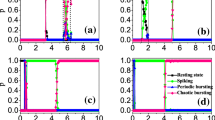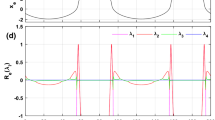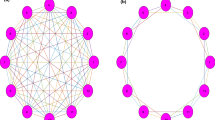Abstract
The study of synchronization and bursting transition is very important and valuable in cognitive activities and action control of brain as well as enhancement for the reliability of the cortex synapses. However, we wonder how the synaptic strength and synaptic delay, especially the asymmetrical time-delays between different neurons can collectively influence their synchronous firing behaviors. In this paper, based on the Hindmarsh-Rose neuronal systems with asymmetrical time-delays, we investigate the collective effects of various delays and coupling strengths on the synchronization and bursting transition. It is shown that the interplay between delay and coupling strength can not only enhance or destroy the synchronizations but also can induce the regular transitions of bursting firing patterns. Specifically, as the coupling strength or time-delay increasing, the firing patterns of the time-delayed coupling neuronal systems consistently present a regular transition, that is, the periods of spikes during the bursting firings increase firstly and then decrease slowly. In particular, in contrast to the case of symmetrical time-delays, asymmetrical time-delays can lead to the paroxysmal synchronizations of coupling neuronal systems, as well as the concentration level of synchronization for the non-identically coupled system is superior to the one of identical coupling. These results more comprehensively reveal the rich nonlinear dynamical behaviors of neuronal systems and may be helpful for us to have a better understanding of the neural coding.
Similar content being viewed by others
References
Xie Y, Kang Y M, Liu Y, et al. Firing properties and synchronization rate in fractional-order Hindmarsh-Rose model neurons. Sci China Tech Sci, 2014, 57: 914–922
Ye W J, Liu S Q, Liu X L. Synchronization of two electrically coupled inspiratory pacemaker neurons. Sci China Tech Sci, 2014, 57: 929–935
Gray C M, Konig P, Engel A K, et al. Oscillatory responses in cat visual cortex exhibit inter-columnar synchronization which reflects global stimulus properties. Nature, 1989, 338: 334–337
Steinmeta P N, Roy A, Fitzgerald P J, et al. Attention modulates synchronized neuronal firing in primate somatosensory cortex. Nature, 2000, 404: 187–190
Han Q K, Sun X Y, Yang X G, et al. External synchronization of two dynamical systems with uncertain parameters. Sci China Tech Sci, 2010, 53: 731–740
Fell J, Fernandez G, Klaver P, et al. Is synchronized neuronal gamma activity relevant for selective attentions. Brain Res Rev, 2003, 42: 265–272
Ma J, Tang J. A review for dynamics of collective behaviors of network of neurons. Sci China Tech Sci, 2015, 58: 2038–2045
Izhikevich E M. Neural excitability, spiking and bursting. Intl J Bifurcat Chaos, 2012, 10: 1171–1266
Wu C, Martel D T, Shore S E. Increased synchrony and bursting of dorsal cochlear nucleus fusiform cells correlate with tinnitus. J Neurosci: Official J Soc Neurosci, 2016, 36: 2068–2073
Song X L, Wang C N, Ma J, et al. Transition of electric activity of neurons induced by chemical and electric autapses. Sci China Tech Sci, 2015, 58: 1–8
Wang H X, Wang Q Y, Zheng Y H. Bifurcation analysis for Hindmarsh-Rose neuronal model with time-delayed feedback control and application to chaos control. Sci China Tech Sci, 2014, 57: 872–878
Postnova S, Voigt K, Braun H A. Neural synchronization at tonicto-bursting transitions. J Biol Phys, 2007, 33: 129–143
Wang H X, Lu Q S, Wang Q Y. Bursting and synchronization transition in the coupled modified ML neurons. Commun Nonlinear Sci Nume Simul, 2007, 13: 1668–1675
Yuan G Y, Zhang G C, Wang G R, et al. Synchronization and asynchronization in two coupled excitable systems. Commun Theor Phys, 2005, 43: 459–465
Nikola B, Ines G, Nebojsa V. Type I vs. type II excitable systems with delayed coupling. Chaos Soliton Fract, 2005, 23: 1221–1233
Dhamala M, Viktor K J, Ding M Z. Enhancement of neural synchrony by time delay. J Phys Rev Lett, 2004, 92: 74104
Rossoni E, Chen Y H, Ding M Z, et al. Stability of synchronous oscillations in a system of Hodgkin-Huxley neurons with delayed diffusive and pulsed coupling. Phys Rev E, 2005, 71: 061904
Duan L X, Fan D G, Lu Q S. Hopf bifurcation and bursting synchronization in an excitable systems with chemical delayed coupling. Cognitive Neurodyn, 2013, 7: 341–349
Zhang J Q, Huang S, Pang S, et al. Optimizing calculations of coupling matrix in Hindmarsh-Rose neural network. Nonlinear Dyn, 2016, 84: 1303–1310
Juang J, Liang Y H. Cluster synchronization in networks of neurons with chemical synapses. Chaos An Interdiscip J Nonlinear Sci, 2014, 24: 013110
Qin H X, Ma J, Jin W Y, et al. Dynamics of electric activities in neuron and neurons of network induced by autapses. Sci China Tech Sci, 2014, 57: 936–946
Sun Z K, Yang X L, Xu W. Taming complexity in nonlinear dynamical systems by recycled signal. Sci China Tech Sci, 2016, 59: 403–410
Lu Q S, Shi X. Complete synchronization of coupled Hindmarsh Rose neurons with ring structure. Chin Phys Lett, 2004, 21: 1695–1698
Belykh I, de Lange E, Hasler M. Synchronization of bursting neurons: What matters in the network topology. Phys Rev Lett, 2005, 94: 188101
Fan D G, Wang Q Y. Improving desynchronization of parkinsonian neuronal network via triplet-structure coordinated reset stimulation. J Theor Bio, 2015, 370: 157–170
Fan D G, Wang Q Y, Perc M. Disinhibition-induced transitions between absence and tonic-clonic epileptic seizures. Scient Rep, 2015, 5: 12618
Sun Z K, Yang X L. Generating and enhancing lag synchronization of chaotic systems by white noise. Chaos, 2011, 21: 033114
Fan D G, Wang Z H, Wang Q Y. Optimal control of directional deep brain stimulation in the parkinsonian neuronal network. Commun Nonlinear Sci Numer Simul, 2016, 36: 219–237
Kwon O, Moon H T. Coherence resonance in small-world networks of excitable cells. Phys Lett A, 2002, 298: 319–324
Wang Q Y, Duan Z S, Perc M, et al. Synchronization transitions on small-world neuronal networks: Effects of information transmission delay and rewiring probability. Europhys Lett, 2008, 83: 50008
Tanakaa G, Ibarz B, Sanjuan M A F, et al. Synchronization and propagation of bursts in networks of coupled map neurons. Chaos, 2006, 16: 013113
Zhou C S, Zemanov L, Zamora G, et al. Hierarchical organization unveiled by functional connectivity in complex brain networks. Phys Rev Lett, 2006, 97: 238103
Leyva I, Sendina-Nadal I, Almendral J A, et al. Sparse repulsive coupling enhances synchronization in complex networks. Phys Rev E, 2006, 74: 056112
Wu S, Wang D, Okubo S. Mechanical engineering control system for the linear time delay with disturbances. In: Proceedings of IEEE 10th International Conference on Computer-Aided Industrial Design & Conceptual Design. IEEE, 2009. 2267–2270
Karimi H R, Moshiri B, Lucas C. Robust fuzzy linear control of a class of stochastic nonlinear time-delay systems. Nonlinear Dyn Syst Theory, 2004, 3: 317–332
Konen C S, Kleiser R, Bremmer F, et al. Global synchronization of general complex dynamical networks with time-varying delay. RO-MAN IEEE, 2007, 182: 833–838
Wu J S, Jiao L. Synchronization in dynamic networks with nonsymmetrical time-delay coupling based on linear feedback controllers. Phys A Stat Mech Its Appl, 2008, 387: 2111–2119
Yang X L, Senthilkumar D V, Sun Z K, et al. Key role of time delay and connection topology in shaping the dynamics of noisy genetic regulatory networks. Chaos, 2011, 21: 047522
Sun Z K, Fu J, Xiao Y Z, et al. Delay-induced stochastic bifurcations in a bistable system under white noise. Chaos, 2015, 25: 083102
Sun Z K, Yang X L, Xiao Y Z, et al. Modulating resonance behaviors by noise recycling in bistable systems with time delay. Chaos, 2014, 24: 023126
Ott W, Rivas M A, West J. Observing Lyapunov exponents of infinite-dimensional dynamical systems. J Stat Phys, 2015, 161: 1098–1111
Rao R P N, Sejnowski T J. Spike-time-dependent Hebbian plasticity as temporal difference learning. Neural Comp, 2001, 13: 2221–2237
Masquelier T, Guyonneau R, Thorpe S J. Competitive STDP based spike pattern learning. Neural Comp, 2008, 21: 1–18
Shampine L F, Thompson S. Solving DDEs in Matlab. Appl Numer Math, 2001, 37: 441–458
Hu H Y, Wang Z H. The research progress of nonlinear dynamical systems with time-delay. Adv Mech, 1999, 29: 501–512
Wang Q Y, Shi X, Lu Q S. Synchronous Dynamics of the Coupled Neural System. Beijing: Science Press, 2008
Rosin B, Slovik M, Mitelman R, et al. Closed-loop deep brain stimulation is superior in ameliorating parkinsonism. Neuron, 2011, 72: 370–384
Author information
Authors and Affiliations
Corresponding author
Rights and permissions
About this article
Cite this article
Fan, D., Wang, Q. Synchronization and bursting transition of the coupled Hindmarsh-Rose systems with asymmetrical time-delays. Sci. China Technol. Sci. 60, 1019–1031 (2017). https://doi.org/10.1007/s11431-016-0169-8
Received:
Accepted:
Published:
Issue Date:
DOI: https://doi.org/10.1007/s11431-016-0169-8




